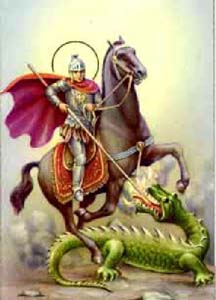

Not much is known of George's early life. Several stories have been attached to Saint George, the best known of which is the Golden Legend. In it, a dragon lived in a lake near Silena, Libya. Whole armies had gone up against this fierce creature, and had gone down in painful defeat. The monster ate two sheep each day; when mutton was scarce, lots were drawn in local villages, and maidens were substituted for sheep. Into this country came Saint George. Hearing the story on a day when a princess was to be eaten, he crossed himself, rode to battle against the serpent, and killed it with a single blow with his lance. George then held forth with a magnificent sermon, and converted the locals. Given a large reward by the king, George distributed it to the poor, then rode away.
Due to his chivalrous behavior (protecting women, fighting evil, dependence on faith and might of arms, largesse to the poor), devotion to Saint George became popular in the Europe after the 10th century. In the 15th century his feast day was as popular and important as Christmas. Many of his areas of patronage have to do with life as a knight on horseback. St. George is the only saint always portrayed fighting mounted. He died as a martyr around.304 at Lydda, Palestine, and a shrine was built for his relics there and was a popular point of pilgrimage for centuries.
The celebrated Knights of the Garter are actually Knights of the Order of Saint George and the US Army Armor Association has an award called The Order of Saint George that it awards to those who have made contributions to US armor.
His Feast Day is April 23.
Please email comments to Fr. Frog by clicking here.
| Back to the Saints Page | Back to Fr. Frog's Home Page |
Updated 2005-10-07 @ 1000